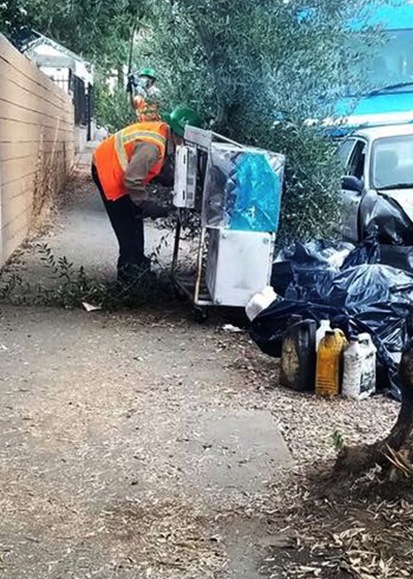By Juliet Bennett Rylah
Contributing Writer
HOLLYWOOD — Activists are calling for the city of Los Angeles to halt homeless encampment sweeps, especially in the vicinity of Vine Street and Lexington Avenue.
Arguing that the sweeps often cause unhoused people more harm than good, by scattering people throughout the community, increasing the potential for virus spread and disconnecting them from service providers.
The Centers for Disease Control and Prevention has recommended that cities allow people who live in encampments to stay where they are if there are no individual housing options available during the pandemic.
Last March, the City Council instructed staff in the L.A. Sanitation and Environment division to suspend encampment cleanups, in accordance with CDC guidance. But in July the council approved a new motion to resume cleanups around the city’s Bridge Home shelters in what are known as Bridge Home special enforcement cleaning zones.
There are two Bridge Home shelters in Hollywood’s 13th Council District, including one at 1533 Schrader Blvd. and the YWCA at 1215 Lodi Place. The Schrader Boulevard shelter is currently full, while the YWCA is only open to women and is currently reporting one COVID-19 case, according to the county Department of Public Health.
The Lexington and Vine area is part of the YWCA’s cleaning zone.
StreetWatch LA, a coalition for tenant rights, has been attending recent sweeps throughout the city, and StreetWatch organizer Tommy Kelly has been conducting outreach near the YWCA. He says the way the city currently operates can hurt unhoused residents through inadequate notice and the subsequent removal or destruction of important property.
Residents are notified of upcoming cleanups with paper or metal signs written in English and Spanish and some outreach, but Kelly says many people are still unaware of when sweeps will occur and what they entail.
“The outreach is pretty bad on behalf of the city, so most people don’t know that it’s coming,” Kelly said. “A lot of times, people don’t even know there’s a zone. They just know there’s a thing that’s happening today. There’s not an understanding of what this program is.”
If someone isn’t at their tent when a sweep occurs, their things could be thrown away or put into a storage facility known as ‘the bin.’ While those facilities keep items for up to 90 days, Kelly says it can be difficult to go pick up property without a car.
Kelly also noted that he has had to show his identification to retrieve belongings for others. Some unhoused people don’t have IDs, and others have listed their I. as one of many items thrown away during sweeps. These difficulties are reflected in data from a 2017 report from the city controller that found just 3-5% of involuntarily stored personal property was recovered from the bin.
Cleanups do sometimes come with useful services for unhoused communities. Per an Oct. 13 report from the sanitation division, the city’s mobile hygiene unit provided 900 showers and more than 2,100 hygiene kits during 71 cleanups conducted between July 21 and Oct. 2, while also removing 276 tons of waste. Councilman Joe Buscaino drew upon the report when he authored a motion authored Oct. 14 asking that cleanups resume citywide.
But Kelly said the positive services don’t have to come with the cleanups that throw away people’s belongings or use police. The problem isn’t that cleanups occur, but they should be about “what sanitation can do for people, not to people,” he said.
“Do trash pickup for them like we do for all of the housed people in the city. Provide them with a service,” Kelly said. “Basic stuff … that makes sense from a human perspective.”
Kelly notes that some of these changes have already happened in the 11th Council District. The Independent reached out to Councilman Mitch O’Farrell’s office, who represents the 13th City Council District, but did not receive a response.
The Services Not Sweeps Coalition offers several recommendations for cleanups. They include removing law enforcement from cleanups; ensuring sweeps are scheduled, regular and well-publicized similar to other city street sweeping services; and providing resources, such as dumpster and trash bins, and alternate shelter if cleaning occurs during extreme weather.
In addition to the short-term changes, another immediate goal for StreetWatchLA is to encourage city officials to house people in places where they could practice social distancing. Currently, L.A. County Public Health data shows a sharp increase in COVID-19 infections among people experiencing homelessness starting in November.
Though the positivity rate among unhoused individuals is lower than the general population, county Public Health Director Barbara Ferrer said during a news briefing Jan. 6 that cases are still rising among all demographics and congregate settings, whether they are shelters or close encampments, are particularly risky.
Options for individual shelter include hotels and motels, or city- and county-owned properties. As an example, Kelly pointed to golf courses, of which L.A. County owns 19.
Los Angeles has secured about 1,800 hotel rooms and apartments through Project Homekey, a state initiative that provides funding to cities and to buy hotels, motels and apartment buildings to shelter unhoused people. But it isn’t enough when compared to the approximately 66,000 unhoused residents in the county, over 41,000 of whom live in the city of Los Angeles.
Juliet Bennett Rylah is a freelance reporter who covers Hollywood and West Hollywood. She can be reached at jbrylah@gmail.com.












